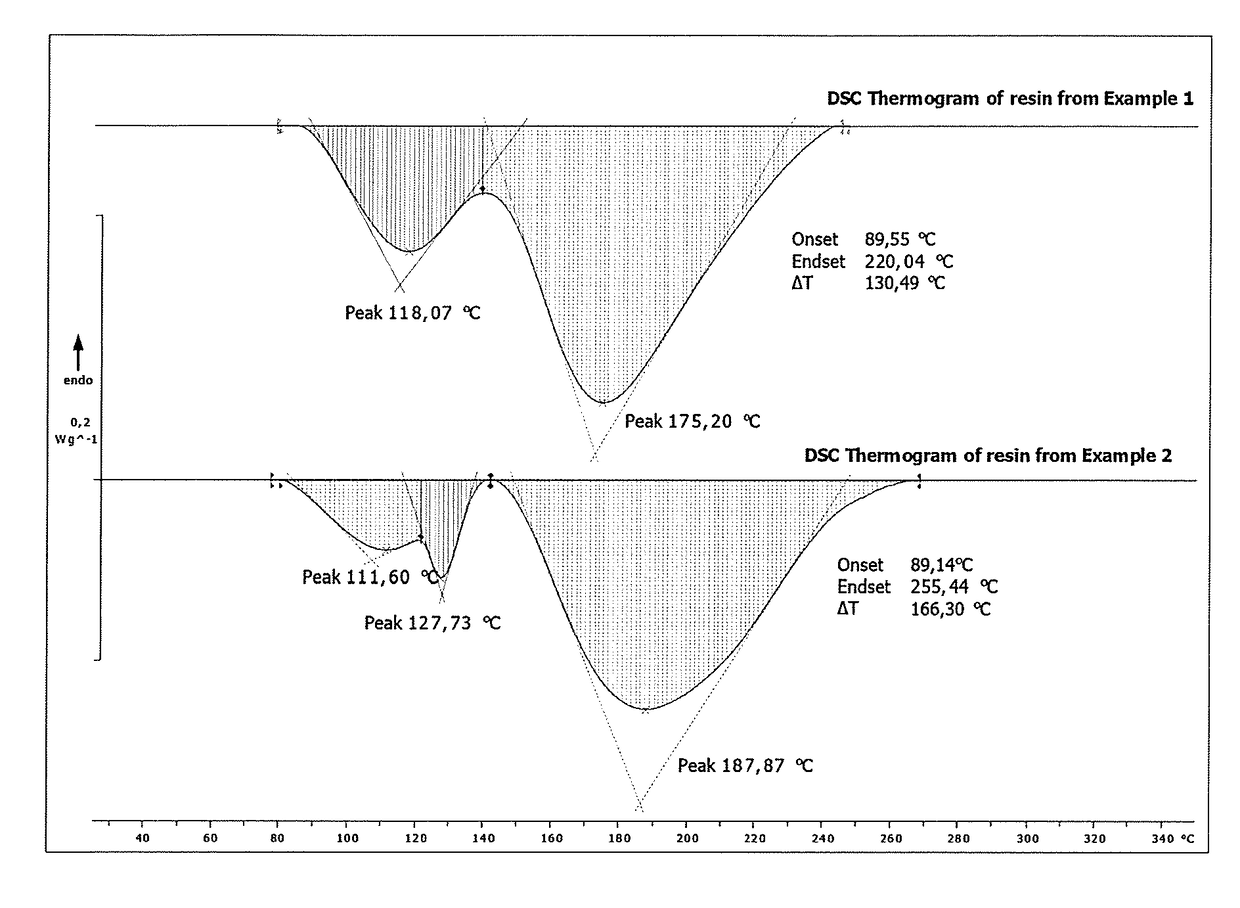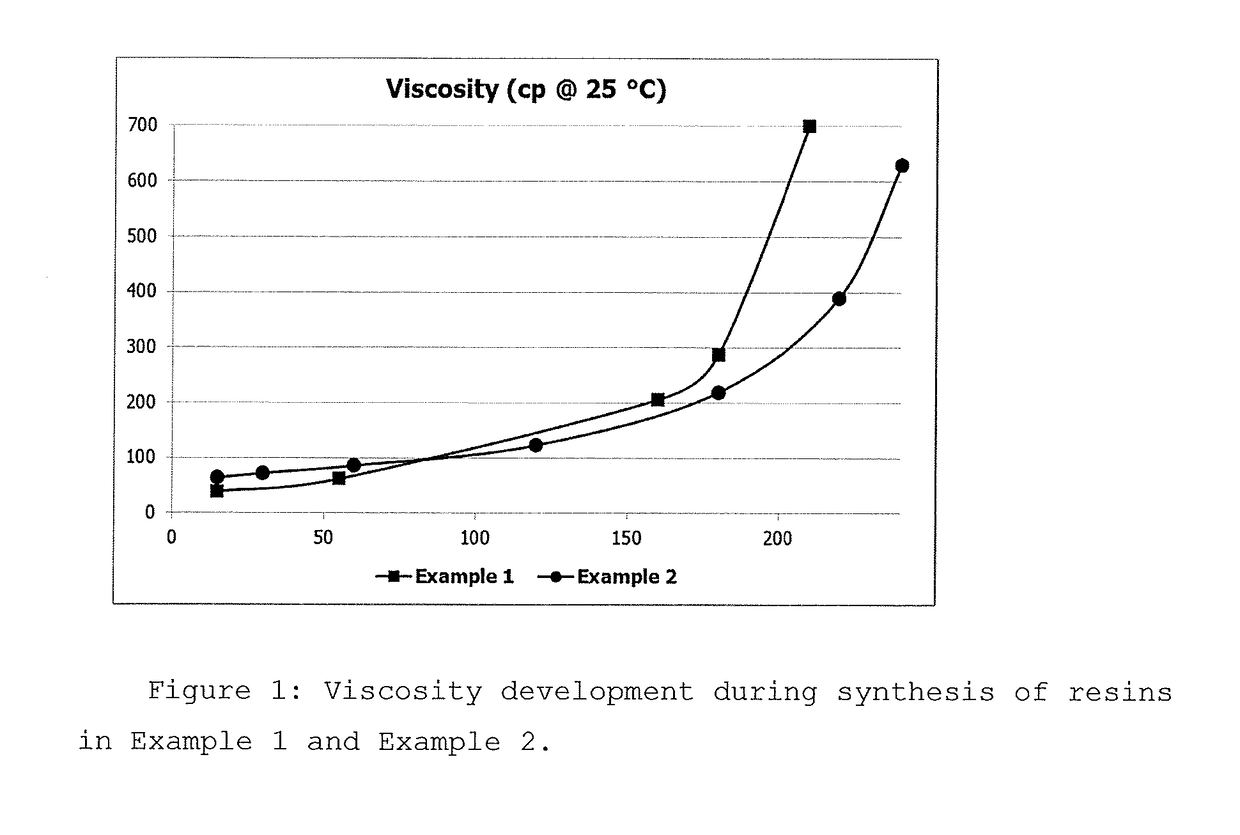An activated lignin composition, a method for the manufacturing thereof and use thereof
- Summary
- Abstract
- Description
- Claims
- Application Information
AI Technical Summary
Benefits of technology
Problems solved by technology
Method used
Image
Examples
example 1
[0049]Lignin-phenol-formaldehyde resin was synthesized with a degree of substitution of the phenol with lignin equal to about 50% by weight. In the first step, lignin dispersion was prepared by mixing of 40 g of lignin (96% lignin), 53 g of water and 11.5 g of sodium hydroxide for 30 minutes using a high shear-dispersing equipment, in this case an IKA T25 ULTRA TURRAX High-Speed Homogenizer equipped with a S25 N18G dispersing element in a glass reactor equipped with condenser, overhead stirrer and thermometer. In the 2nd step, 40 g of phenol (99% Phenol) and 124 g of formaldehyde solution (37% formaldehyde in methanol) were added to the glass reactor. The formaldehyde to phenol ratio was set to 1.8 to facilitate detection of sufficient levels of free monomers. The pH of the solution was adjusted to 11.5 with the addition of an aqueous solution of 45% sodium hydroxide. The reaction mixture was cooked at 80° C. until the viscosity of the reaction mixture reached a certain viscosity. T...
example 3 (
E.1)
[0054]Lignin-phenol-formaldehyde resin was synthesized with a degree of substitution of the phenol with lignin equal to about 50% by weight. 42.6 g of lignin (96% lignin), 40 g of phenol (99% Phenol), 37.4 g of water and 110 g of 37% formaldehyde solution were combined in a glass reactor equipped with condenser, overhead stirrer and thermometer. The formaldehyde to phenol ratio was set to 1.6. The pH of the solution was adjusted to 11.5 with the addition of an aqueous solution of 45% sodium hydroxide. The reaction mixture was cooked at 80° C. until the viscosity of the reaction mixture reached a certain viscosity. After the reaction mixture reached the certain viscosity, it was cooled rapidly to room temperature using a cold water bath. Viscosity development is illustrated in FIG. 3.
[0055]The final resin was investigated by means of gel time analysis and dynamic light scattering. Gel time was determined using a Techne GT-6 Gelation Timer with a 15 mm plunger which was submerged ...
example 4 (
E.2)
[0057]Lignin-phenol-formaldehyde resin was synthesized with a degree of substitution of the phenol with lignin equal to about 50% by weight. In the first step, lignin dispersion was prepared by mixing of 42.6 g of lignin (96% lignin), 40 g of phenol, 37.4 g of water and 23 g of 45% sodium hydroxide solution for 90 minutes using a high shear-dispersing equipment, in this case an IKA T25 ULTRA TURRAX High-Speed Homogenizer equipped with a S25 N18G dispersing element in a glass reactor equipped with condenser, overhead stirrer and thermometer. In the 2nd step, 110 g of 37% formaldehyde solution were added to the glass reactor and mixed with a propeller stirrer instead of high speed homogenizer. The formaldehyde to phenol ratio was set to 1.6.
[0058]The pH of the solution was adjusted to 11.5 with the addition of an aqueous solution of 45% sodium hydroxide. The reaction mixture was cooked at 80° C. until the viscosity of the reaction mixture reached a certain viscosity. The viscosity...
PUM
| Property | Measurement | Unit |
|---|---|---|
| Particle size | aaaaa | aaaaa |
| Particle size | aaaaa | aaaaa |
| Particle size | aaaaa | aaaaa |
Abstract
Description
Claims
Application Information
 Login to View More
Login to View More - R&D
- Intellectual Property
- Life Sciences
- Materials
- Tech Scout
- Unparalleled Data Quality
- Higher Quality Content
- 60% Fewer Hallucinations
Browse by: Latest US Patents, China's latest patents, Technical Efficacy Thesaurus, Application Domain, Technology Topic, Popular Technical Reports.
© 2025 PatSnap. All rights reserved.Legal|Privacy policy|Modern Slavery Act Transparency Statement|Sitemap|About US| Contact US: help@patsnap.com



